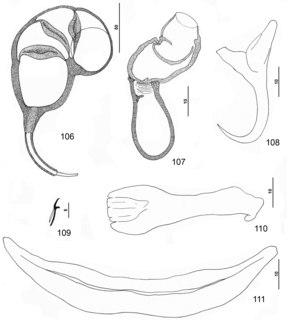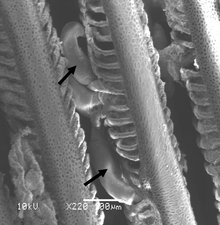
Pseudorhabdosynochus is a genus of monopisthocotylean monogeneans, included in the family Diplectanidae.The type-species of the genus is Pseudorhabdosynochus epinepheli .

Pseudorhabdosynochus epinepheli is a diplectanid monogenean parasitic on the gills of species of groupers. It is the type species of the genus Pseudorhabdosynochus Yamaguti, 1958.

Pseudorhabdosynochus capurroi is a diplectanid monogenean parasitic on the gills of the Black grouper, Mycteroperca bonaci. It was described by Vidal-Martínez and Mendoza-Franco in 1998 and redescribed successively by Yang, Gibson and Zeng in 2005 and by Kritsky, Bakenhaster and Adams in 2015.

Pseudorhabdosynochus monaensis is a diplectanid monogenean parasitic on the gills of the Rock hind, Epinephelus adscensionis. It has been described by Dyer, Williams & Bunkley-Williams in 1994 and redescribed by Kritsky, Bakenhaster and Adams in 2015.

Pseudorhabdosynochus beverleyburtonae is a diplectanid monogenean parasitic on the gills of the dusky grouper, Epinephelus marginatus. It has been described by Guy Oliver in 1984 as Cycloplectanum beverleyburtonae, redescribed by Oliver in 1987, transferred to the genus Pseudorhabdosynochus by Kritsky & Beverley-Burton in 1986 as Pseudorhabdosynochus beverleyburtonae, redescribed by Kritsky, Bakenhaster and Adams in 2015, and redescribed in 2016 by Chaabane, Neifar, Gey & Justine.
Pseudorhabdosynochus buitoe is a diplectanid monogenean parasitic on the gills of the Highfin grouper, Epinephelus maculatus. It has been described in 2007.
Pseudorhabdosynochus euitoe is a diplectanid monogenean parasitic on the gills of the Highfin grouper, Epinephelus maculatus. It has been described in 2007.
Pseudorhabdosynochus amplidiscatus is a diplectanid monogenean parasitic on the gills of groupers. It was described as Diplectanum amplidiscatum by Bravo-Hollis in 1954 and transferred to the genus Pseudorhabdosynochus by Kritsky and Beverley-Burton in 1986.
Pseudorhabdosynochus bocquetae is a diplectanid monogenean parasitic on the gills of groupers. It has been described in 1984 by Guy Oliver and Ilan Paperna. The species was first described as Cycloplectanum bocquetae and transferred to the genus Pseudorhabdosynochus by Delane C. Kritsky and Mary Beverley-Burton in 1986.
Pseudorhabdosynochus podocyanus is a species of diplectanid monogenean that is parasitic on the gills of the blue grouper Epinephelus cyanopodus. It was described in 2008.
Pseudorhabdosynochus cupatus is a species of diplectanid monogenean parasitic on the gills of groupers.
Pseudorhabdosynochus hargisi is species of a diplectanid monogenean parasitic on the gills of the White grouper Epinephelus aeneus. It was described in 1984 as Diplectanum hargisi and transferred to the genus Pseudorhabdosynochus by Santos, Buchmann & Gibson in 2000. Its systematic position has been clarified by Kritsky, Bakenhaster & Adams in 2015, who differentiated it from Pseudorhabdosynochus americanus.
Pseudorhabdosynochus melanesiensis is a diplectanid monogenean parasitic on the gills of the grouper, Epinephelus merra. It was described in 1958 as Diplectanum melanesiensis then transferred to the genus Pseudorhabdosynochus by Kritsky & Beverley-Burton in 1986.

Pseudorhabdosynochus riouxi is a species of diplectanid monogenean parasitic on the gills of dusky grouper Mycteroperca marginata. It was described by Guy Oliver in 1986 as Cycloplectanum riouxi, then transferred to the genus Pseudorhabdosynochus by Santos, Buchmann & Gibson in 2000. The species has been redescribed by Chaabane et al. in 2017.
Pseudorhabdosynochus magnisquamodiscum is species of diplectanid monogenean parasitic on the gills of a fish. It was described in 1984 under the name Cycloplectanum magnisquamodiscum and later transferred to the genus Pseudorhabdosynochus.
Pseudorhabdosynochus serrani is a species of diplectanid monogenean parasitic on the gills of a fish. It was described in 1953 by Satyu Yamaguti as Diplectanum serrani and later transferred to the genus Pseudorhabdosynochus. The species has been redescribed in 2005.
Pseudorhabdosynochus shenzhenensis is a species of diplectanid monogenean parasitic on the gills of the grouper Epinephelus coioides. It was described in 2005.
Pseudorhabdosynochus summanoides is a species of diplectanid monogenean parasitic on the gills of the orange-spotted grouper Epinephelus coioides. It was described in 2005.
Pseudorhabdosynochus summanae is a species of diplectanid monogenean parasitic on the gills of the grouper Epinephelus summana. It was described in 1969, from only four specimens, under the name Diplectanum summanae and transferred to the genus Pseudorhabdosynochus in 1986.
Pseudorhabdosynochus querni is a species of diplectanid monogenean parasitic on the gills of the grouper Epinephelus quernus. It was described in 1968 by Satyu Yamaguti under the name Diplectanum querni and transferred to the genus Pseudorhabdosynochus in 1986. The species has been redescribed in 2005 from the type-material.






